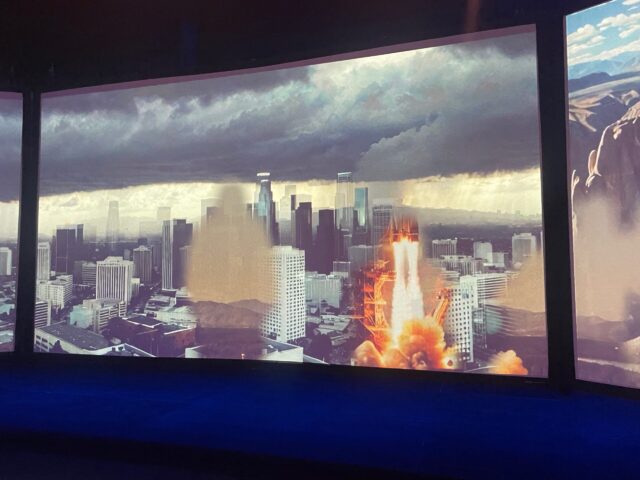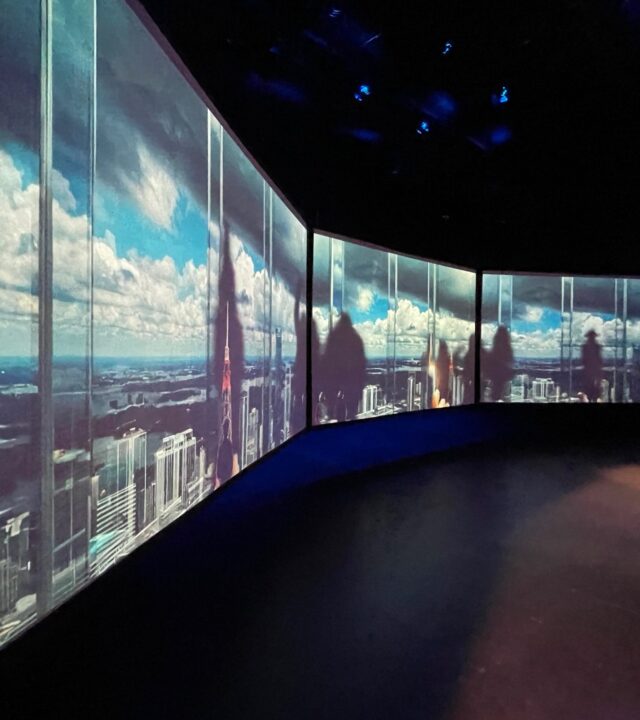
The Vivid Unknown uses generative AI and immersive sound to reimagine Godfrey Reggio’s Koyaanisqatsi (photo by twi-ny/mdr)
TECHNE: THE VIVID UNKNOWN
Under the Radar Festival / BAM Next Wave
BAM Fishman Space
321 Ashland Pl.
January 4-7, $10
Series continues through January 19
utrfest.org
www.bam.org
“I like people to break things. I’m always interested in how kids interact with things because they’re going to do things that someone else might not do,” artist John Fitzgerald told me at the inaugural presentation of TECHNE: The Vivid Unknown at BAM’s Fishman Space, a multimedia reimagining of Godfrey Reggio’s 1982 documentary Koyaanisqatsi, which means “life out of balance,” “life disintegrating,” and “a state of life that calls for another way of living” in the Hopi language.
Fitzgerald was not referring to the hardware but “the rules of engagement” that he’s designed with an expert team. “Anyone can bring their own story to it. That’s something I learned from Godfrey, who calls it the autodidactic experience of watching Koyaanisqatsi,” he said. “He’s not telling you, ‘technology bad, humans good — the natural world is safe.’ He’s giving you the opportunity to have thoughts about things, to experience things. Everyone will always watch it differently. I’ve seen that movie dozens and dozens of times; there are a lot of different ways that you can interpret it. So I’m excited to see how this evolves and unfolds. People might want to come in here and sit down on the floor, they might want to go out and get some fresh air and come back in; it’s an open experience.”
There are numerous ways to experience The Vivid Unknown, and it’s left up to each individual to decide, mimicking how we approach life. AI-generated images speed across three large screens as immersive AI sound envelops the room. You can sit on the floor right in front, move around, or take a regular seat in the back. If you decide to participate — and I highly recommend you do — you will discover that when you are in an oval of light, the shape of your body will be picked up by sensors behind you and your onscreen silhouette will eventually be filled by an image different from what is already being projected.
For example, amid slow-motion and time-lapse shots of beachgoers, mountains, metropolitan cities, airplanes, waterfalls, clouds, traffic, the demolition of a housing project, and other scenes, a rocket taking off fit into my outline and followed me onscreen as I walked across the room. Meanwhile, a woman stood near the middle, moving like a dancer. Couples posed together. A few kids jumped up and down. Humanity fused together with technology and the environment as some of us participated and others merely watched from the back.
Almost all the young boys and girls chose to become involved with the art, which brought out the child in the adults who got up from their seats and interacted with it as well. Noticing that, Fitzgerald, who has a five-year-old and a four-month-old, said that the older one is “the best product tester out there. He’s the first to be, like, ‘That’s too long,’ or ‘I want to see more of that.’ He speaks without a filter.”
Curated by Onassis ONX, TECHNE consists of four digital installations that are part of BAM’s Next Wave Festival and Under the Radar; it begins January 4-7 with The Vivid Unknown and continues January 8-11 with Marc Da Costa and Matthew Niederhauser’s The Golden Key, January 12-15 with Margarita Athanasiou’s Voices, and January 16-19 with Stephanie Dinkins’s Secret Garden. (Tickets for each is $10; a series pass is $35.) BAM Rose Cinemas will be showing Koyaanisqatsi on January 7 at 7:30, with Fitzgerald and Vivid Unknown codirector Reggio on hand for the conversation “Terra techno firma” afterward.
Onassis ONX NY program director Jazia Hammoudi shared information with me about how it all works, but I opted to discover much of The Vivid Unknown on my own, which was extremely satisfying. In the program, she writes, “The refined interactivity of the work’s music and visuals subverts the source material’s linear minimalism and subtly engages the body in epic vistas from mountainscapes to oil fields. Within The Vivid Unknown’s zone of immersion, the connection between individual and collective action reflects the complex relationships between human agency and planetary outcomes.” In addition to TECHNE, Onassis ONX is presenting Christiana Kosiar’s RUNWAY and Viola He’s A {room} of one’s own January 10-14 at the Olympic Tower on Fifth Ave. as part of Under the Radar’s Under Construction series.
Fitzgerald met Reggio about two years ago, when he went out to Santa Fe to visit the now-eighty-four-year-old filmmaker, who also made the sequels Powaqqatsi in 1988 and Naqoyqatsi in 2002; all three films in the series feature original soundtracks by Philip Glass.

Audience participation enhances experience of multimedia The Vivid Unknown by John Fitzgerald and Godfrey Reggio (photo by twi-ny/mdr)
Since this was the first public presentation of the work at BAM, I asked Fitzgerald what he thought about the audience’s response.
“It’s exceeding expectations on all levels,” he said. “We’ve never had this many people in it. One of the things about making creative technology art is that it’s always half broken until it’s not, until you have to press play and make sure everything comes together. The idea was that Koyaanisqatsi is a depiction of the state of the world in the latter half of the twentieth century as chaos unfolded. So I was just playing around with this idea of how you don’t really control anything but you do have an impact on this.”
That concept is also represented by a video sculpture off to one side, a refurbished slot machine that was transformed into an interactive artwork by the fabrication studio Chateau Brooklyn. When you pull down the S2000 lever, images speed by a trio of small monitors; it offers an additional moment of connection, but it has no effect on the film. It exists on its own, but it offers a sense of power and involvement even though the results are random. One boy was having a blast with it, pulling the lever a few dozen times, too young to consider the metaphor of how we gamble in life, taking or avoiding risk.
At several points, the barrage of images dropped out and the screens went dark; only the shapes of the audience members standing in the oval of light could be seen. “I want people to feel like they’re making an impact on the images,” Fitzgerald said. “That’s why the last state is left this way; the film disappears, and it’s fuel to give a reflection of your presence.”
He was also quick to share credit. “This is a project made by a dozen artists; it’s truly a collaborative effort,” Fitzgerald explained. “Everyone is unified behind Godfrey and his vision to show humans where we are right now. It’s like a mirror into ourselves.”
[Mark Rifkin is a Brooklyn-born, Manhattan-based writer and editor; you can follow him on Substack here.]